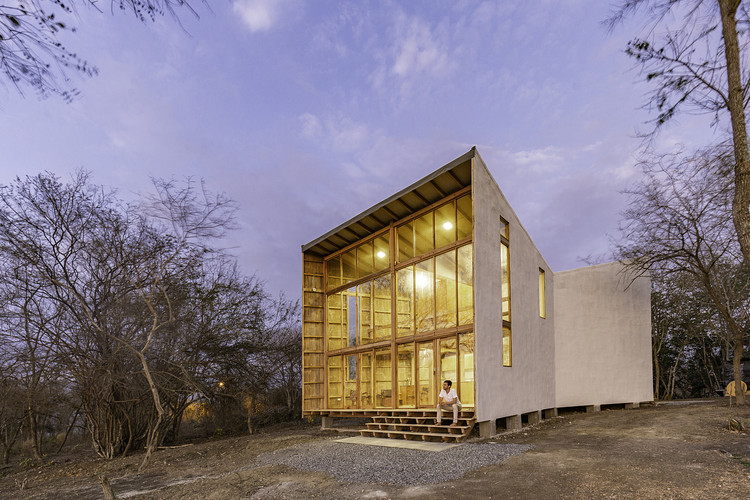Wilson Garden House Architecture Paradigm
2014-04-11 01:00
架构师提供的文本描述。班加罗尔位于威尔逊花园的密集的城市社区,它在西边被邻居们半英亩的森林花园环绕着,让我们大吃一惊。那个花园里茂密的树木种植园给人一种近郊或森林附近的感觉。这座房子占地6000平方英尺,是这个邻里土地的一部分,它的标志是有成熟的树木。在工地上,我们有被树木包围和庇护的感觉。吸引你注意的是光在树枝和树叶中的作用,这是相当戏剧性的。另一个方面是,该遗址的大部分是由松散的,但大的岩石组成的。这个设计是由这个网站的特点所驱动的,那里的想法是关于一个多孔的结构,吸收并内化了这个地方固有的品质。
Text description provided by the architects. Located in dense urban neighbourhood of Wilson garden, Bangalore the site came as a surprise to us as it was flanked in the west by more than half an acre of wooded garden of the neighbours. The dense plantation of trees in that garden gives one the feeling of being in the suburb or near a forest. The 6000 square feet site for the house was earlier a part of this neighbours land and is marked by the presence of mature trees. Being in the site gave us the feeling of being enveloped and sheltered by the trees. What catches your attention is the play of light through branches and leaves, which is quite dramatic. The other aspect was that the large part of the site was made up of loose, but large rocks. The design was driven by this character of the site where the idea was about a porous structure that absorbed and internalized this innate quality of the place.
这个想法演变成一个展馆的概念,吸收上面的景观,并作为一个挖掘洞穴,就像下面的空间。这个想法支持了这个精心设计的项目,它是一个五卧室的房子,有专属的娱乐空间,其中包括游泳池、家庭影院和水疗中心。展馆容纳了起居空间和卧室,而洞穴容纳了娱乐空间和游泳池。提出这一建议是为了解决隐私、停车和硬顶阶层等问题。这一提高也帮助空间更好地暴露在沿着西部边缘的树木景观,让我们从字面上借用它作为体验的一部分。在网站内树木的位置是用来对齐空间的几何图形,在那里它们成为提供体验的关键元素。卧室位于西边,在西边也意味着要处理阳光和隐私。树木提供了第一级阴影,然后是设计的可移动垂直鳍。这样,居住者就可以在欣赏风景的同时控制光线和隐私的数量,给建筑一个充满活力的立面。鳍是详细的,以创造阴影,导致纹理,软化边缘,并给予它的深度感。起居和就餐占据下一层的卧室后,他们都是分开的普加房间和液压玻璃电梯外壳。
The idea evolved into a notion of a pavilion absorbing the landscape above and as an excavated cave like space below. This idea supported the elaborate program, which was a five bedroom house with exclusive spaces for entertainment which included a swimming pool, home theatre and a spa. The pavilion accommodated the living spaces and the bedrooms, while the cave accommodated the entertainment spaces and the pool. It was raised to address issues of privacy, parking and the hard top strata. This raising also helped the spaces get better exposure to the wooded landscape along the western edge, allowing us to literally borrow it as a part of the experience. Location of trees within the site are used to align the geometries of spaces, where they become key elements informing the experience. Bedrooms were located along the western edge, being in the west also meant one had to deal with sun and privacy. The trees provided the first level of shading followed by the designed movable vertical fins. This allowed the occupants to control amount of light and privacy required while enjoying the views, giving the building a dynamic façade. The fins are detailed to create shadows leading to textures softening the edge and lending a sense of depth to it. Living and dining occupies the next layer after the bedrooms they both are separated by the puja room and hydraulic glass lift enclosure.
生物向沿北缘建造的一个大花园开放,这一大花园由毗邻这一边缘的邻近结构进一步定义,而在北部和东部则使其具有庭院的特征。水体被引入房子,因为热调节器,一个侧面的生物,另一个是在两个卧室之间对着树在地点沿西边的边缘。双层玻璃体积的房子,水体与室外结合,通过把森林的看法,进入建筑的内部部分。水也为餐饮创造了前景,通过倒影捕捉天空和周围环境。在餐厅里,你还可以看到南面墙上的雨树树干的雕塑。这棵树的树干可以侵入房子的各个部分,一个穿过厨房,另一个穿过厕所,给它独特的空间。客厅和餐厅都是双高空间,把楼上的卧室和下面的生活水平结合起来。生活水平在视觉上与娱乐或洞穴相连,就像空间通过厨房旁边的剪裁一样。光到这个最底层的调制带来了洞穴般的空间的体验。滤光通过战略位置的天空灯,一些位于水体的上层。每一个层次的物质性都放大了展馆和洞穴的概念。白色的抹灰表面和上面的黄色大理石增加了展馆体积的轻盈度。黑色纹理花岗岩和石砾是用来渲染较低的洞穴般的体积。在房子的任何部分,人们都会微妙地想起这个地方的性质及其变化的特征。设计更多的是关于经验,而不是单纯的形式。创造的空间允许沉思和社交,使家庭有机会聚在一起庆祝这个地方和生活。
The living opens to a large garden created along the northern edge, which is further defined by the neighbouring structures abutting this edge and in the north and the east giving it the character of a courtyard. Water bodies are introduced into the house as thermal regulators one flanks the living and the other is between two bedrooms aligned to the tree in the site along the western edge. The double height glass volume housing the water body integrates with outdoors by bringing the views of the woods into the inner part of the building. The water also creates a foreground for the dining capturing the sky and surroundings through reflections. Being in the dining room also orients one to sculptural trunk of the rain tree framed by the southern wall. The trunks of this tree are allowed to invade various parts of the house, one goes through the kitchen and the other goes through toilet giving the space it's unique character. The living and dining are double height spaces integrating the upper bedrooms with the living levels below. The living level visually connects with the entertainment or the cave like space through a cut out alongside the kitchen. Modulation of light to this lowermost level brings about the experience of the den like space. Light filters through the strategically located sky lights, some located in the water bodies at the upper level. The materiality at each of the levels amplifies the idea of the pavilion and the cave. The white plastered surfaces and the yellow marble at the upper level add to the lightness of the pavilion volume. Black textured granite and stone grit are used to render the lower cave like volume. Being in any part of the house one is subtly reminded of the nature of the place and its changing character. The design becomes more about experiences than the form alone. The created spaces allow for contemplation and also socializing, giving opportunities for families to come together celebrating the place and life.
Architects Architecture Paradigm
Location Bangalore, India
Design Team Sandeep J, Vimal Jain, Manoj Ladhad, Savitha
 举报
举报
别默默的看了,快登录帮我评论一下吧!:)
注册
登录
更多评论
相关文章
-

描边风设计中,最容易犯的8种问题分析
2018年走过了四分之一,LOGO设计趋势也清晰了LOGO设计
-

描边风设计中,最容易犯的8种问题分析
2018年走过了四分之一,LOGO设计趋势也清晰了LOGO设计
-

描边风设计中,最容易犯的8种问题分析
2018年走过了四分之一,LOGO设计趋势也清晰了LOGO设计








































































